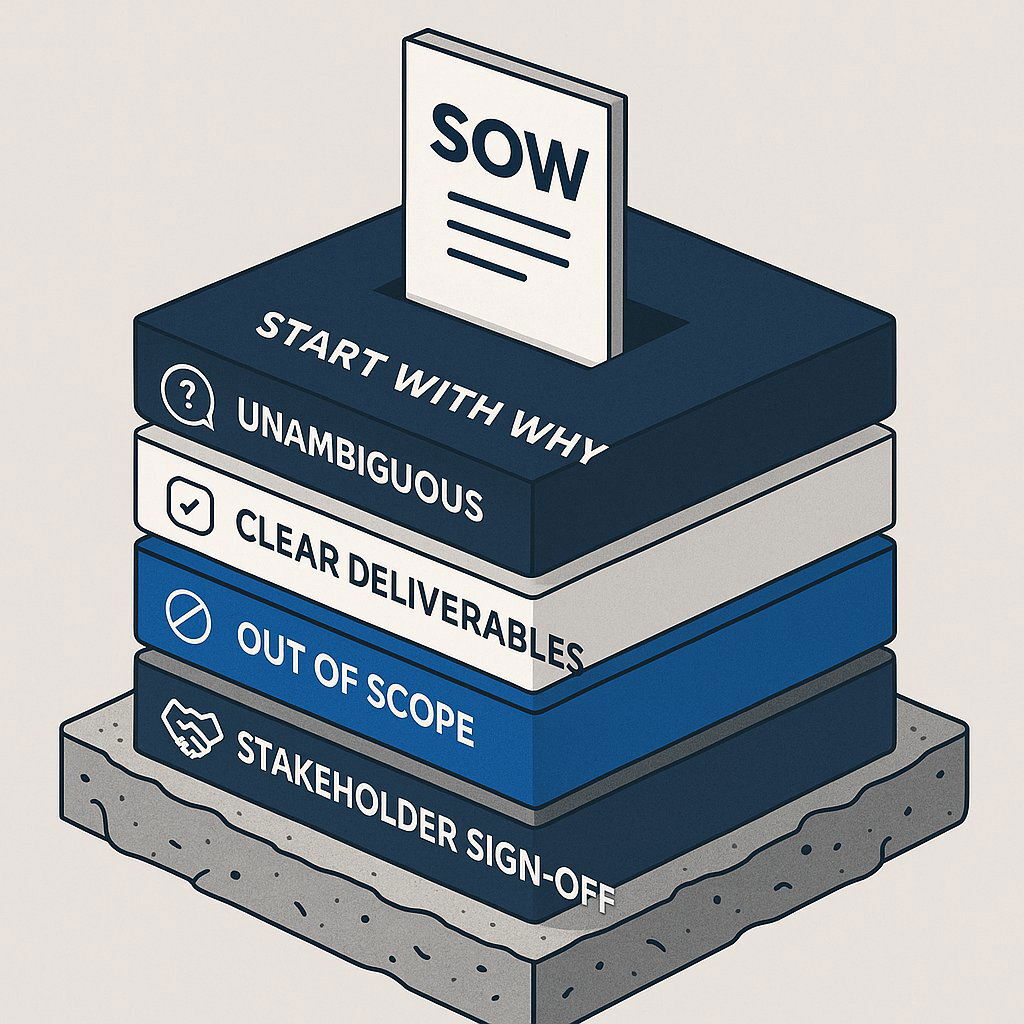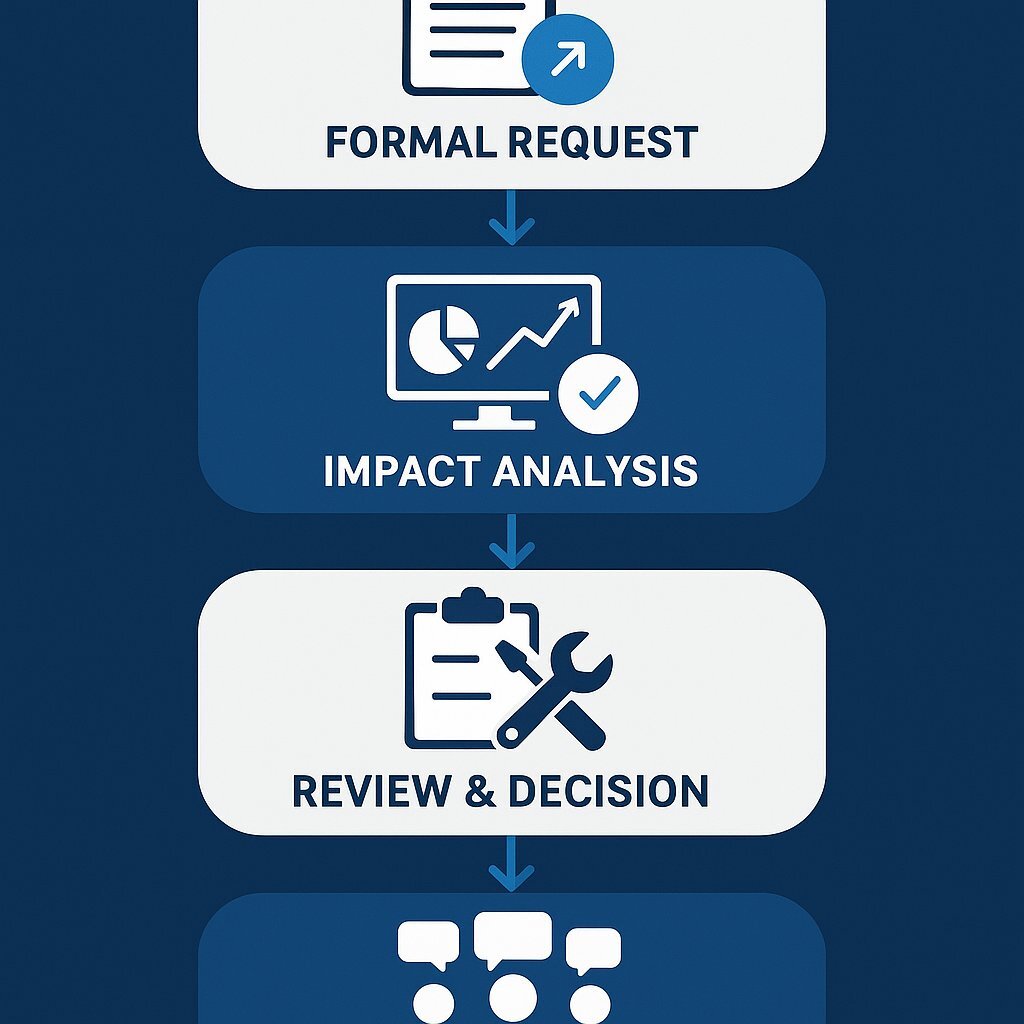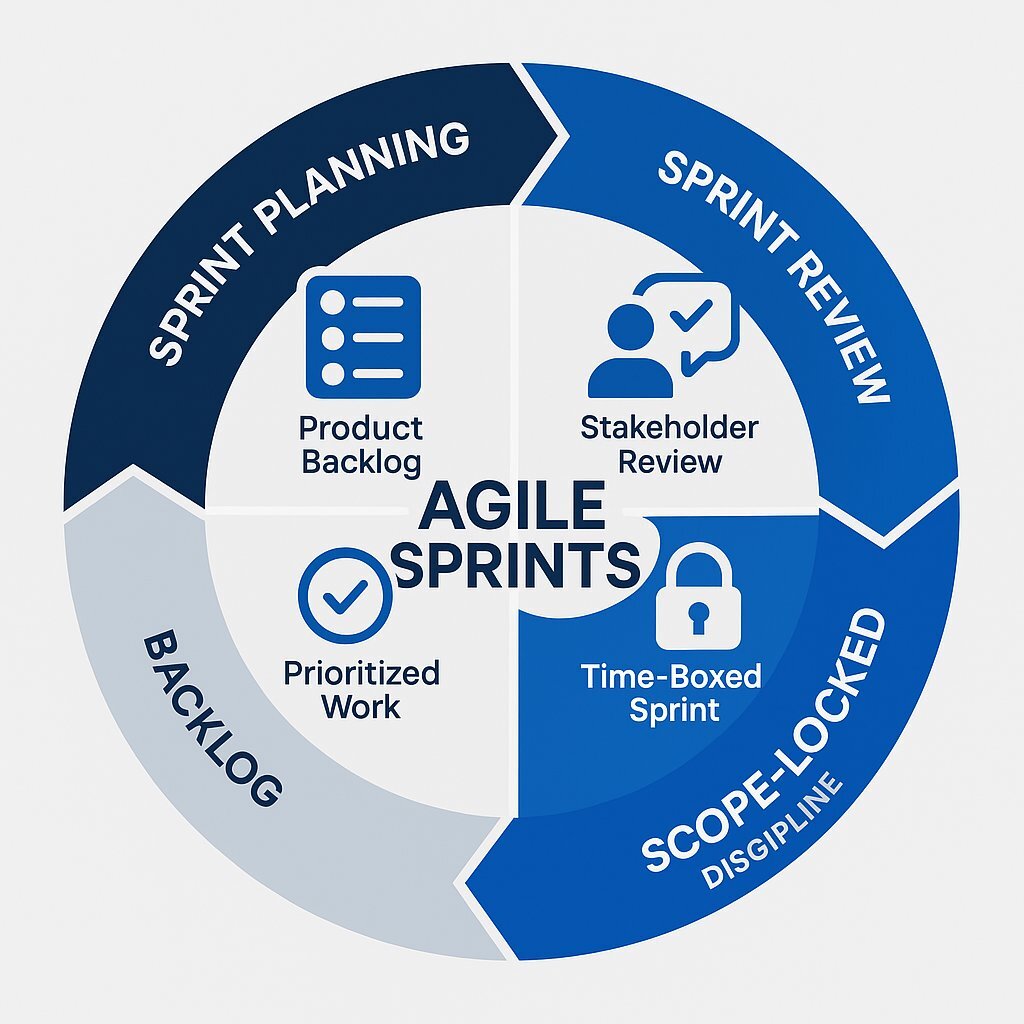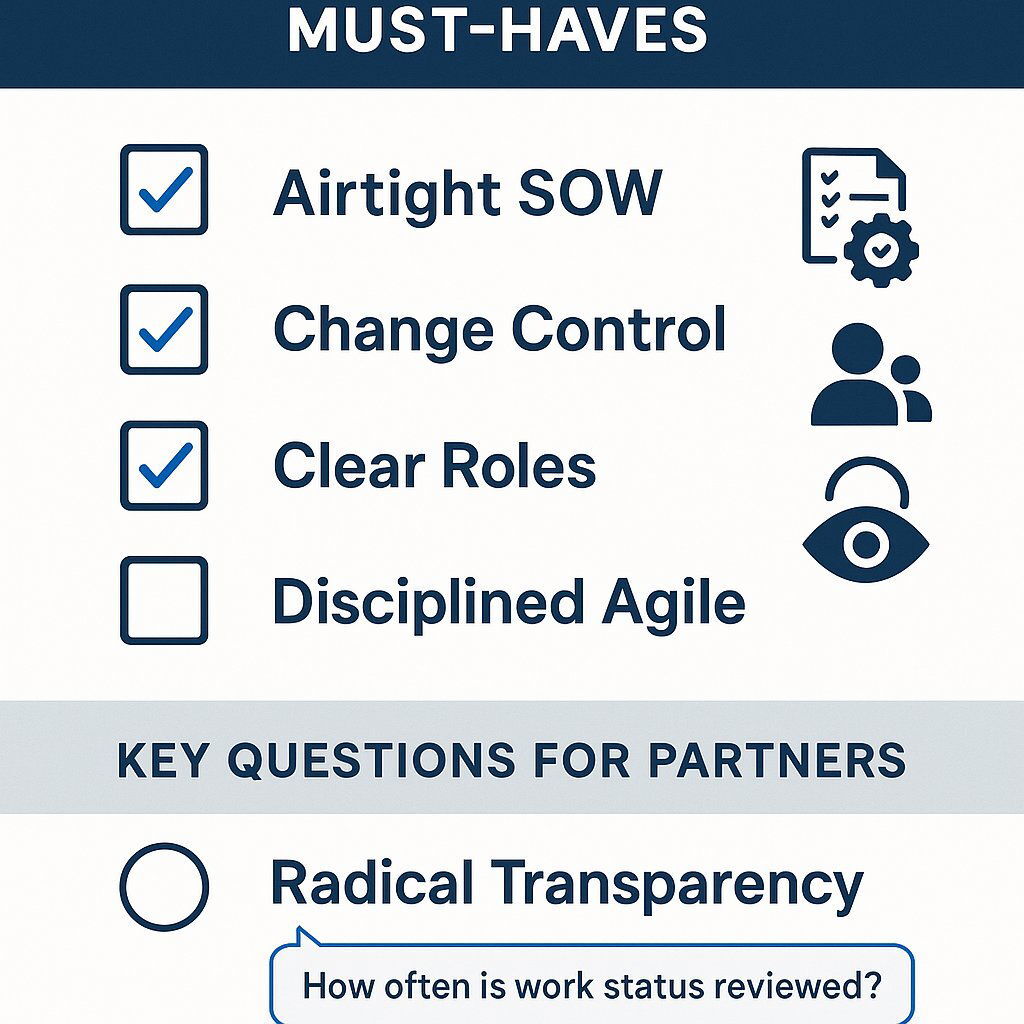
How to Prevent Scope Creep in Software Projects: Baytech Consulting’s Proven Strategy
September 17, 2025 / Bryan Reynolds
Our Strategy for Preventing Scope Creep and Keeping Your Project on Track
You’ve been there before. A project kicks off with a clear vision, an approved budget, and an ambitious timeline. Everyone is aligned and excited. But then, it begins. A small request here. A "minor" feature addition there. A new stakeholder chimes in with a "must-have" idea. Slowly, quietly, the project starts to drift. Before you know it, your timeline has slipped, your budget is stretched thin, and your team is burning out trying to hit a moving target. That slow, insidious drift is called scope creep, and it's one of the primary reasons custom software projects fail.
The question on every leader's mind is, "How do you actually prevent this from happening? How do you keep a complex software project on track, on time, and on budget?"
At Baytech Consulting, we’ve built our reputation on delivering enterprise-grade custom software with predictable success. Our clients in demanding sectors like finance, healthcare, and high-tech praise our efficiency and on-time delivery because we don't leave scope to chance. Our strategy isn't a secret; it's a disciplined, transparent system built on decades of experience. This is our blueprint for preventing scope creep and ensuring your project delivers precisely the value it promised.
The Silent Project Killer: Understanding the True Business Cost of Scope Creep
To defeat an enemy, you must first understand it. Scope creep—sometimes called "requirement creep" or "feature creep"—is the phenomenon where a project's requirements expand beyond their original, agreed-upon boundaries without a corresponding adjustment in time, budget, or resources. It’s not one single decision but a "death by a thousand cuts" that quietly derails even the most well-intentioned initiatives.
Beyond the Buzzword: What Scope Creep Really Is (And Isn't)
Not all change is bad. In fact, adapting to new information or market shifts is a sign of a healthy project. The danger lies in uncontrolled change. To lead a project effectively, it's critical to distinguish between three very different types of project evolution:
| Term | Description | Source of Change | Impact on Plan | Our Verdict |
|---|---|---|---|---|
| Scope Creep | Unplanned, unapproved additions or alterations to the project's requirements. | Often informal requests from clients, stakeholders, or executives. | Erodes budget and timeline without formal acknowledgment or adjustment. | The Project Killer. A sign of poor process and a direct threat to success. |
| Gold Plating | The development team adds extra features or refines existing ones beyond the original requirements, believing it will "impress" the client. | The internal project team, acting on good but misguided intentions. | Wastes valuable time and resources on unrequested, potentially low-value work. | A Hidden Threat. It consumes resources and can introduce unnecessary complexity. |
| Scope Change | A formal, documented, and approved alteration to the project's scope. | A formal change request from any stakeholder, evaluated for its business value. | The project plan, timeline, and budget are officially updated to reflect the new scope. | Healthy Evolution. A sign of a mature, adaptive process that responds to real business needs. |
Understanding this distinction is the first step toward control. At Baytech, we embrace controlled Scope Changes as part of our adaptive process, but we have a zero-tolerance policy for Scope Creep and Gold Plating.
The Domino Effect: Quantifying the Impact on Your Bottom Line
Many executives underestimate scope creep, viewing it as a minor project management headache. The data paints a much darker picture. Unmanaged scope is a financial and operational catastrophe that creates a domino effect across the entire organization. If you want a clear-eyed look at the broader financial risks, see our comprehensive guide to budgeting custom software for new ways to protect your investment.
According to the Project Management Institute (PMI), a staggering 50% of all projects experience scope creep . This isn't a rare occurrence; it's a coin-toss probability for any given initiative. The consequences are severe:
Massive Budget Overruns: Large-scale IT projects, which are particularly vulnerable, run an average of 45% over budget , with scope issues being a primary cause. Globally, organizations lose an estimated
$97 million for every $1 billion invested due to poor project performance and scope mismanagement.
- Shattered Timelines: When scope expands, deadlines are the first casualty. Only 51% of projects are finished on schedule . A project intended to give you a competitive edge can launch so late that the market window has already closed, ceding critical ground to your rivals.
- The Human Cost: Perhaps the most overlooked impact is on your team. When new requirements are piled on without adjusting the timeline, your engineers are forced into a high-pressure, unsustainable work environment. This leads directly to stress, demotivation, and burnout, which in turn drives down quality and increases employee turnover.
- Eroded Trust and Damaged Reputation: When a project is perpetually delayed and over budget, it erodes trust between the business, the development team, and external stakeholders. A failure to deliver on promises can damage your brand's reputation and jeopardize future business relationships.

This cascade of negative outcomes creates a vicious cycle. To meet unrealistic deadlines caused by scope creep, teams are often forced to cut corners, particularly on quality assurance and testing. This results in a product riddled with bugs and technical debt. This low-quality output then requires extensive post-launch support and rework, consuming the very resources—time, money, and developer focus—that should be allocated to your next strategic initiative. In this way, the scope creep from one failed project systemically starves future projects of the resources they need to succeed, perpetuating a culture of project failure and throttling innovation across the organization. For more on how to avoid this cycle after launch, our executive guide to software maintenance provides proven frameworks.
The Baytech Blueprint: Our Proactive, Three-Pillar Strategy for Scope Control
The only way to break this cycle is with a proactive, disciplined strategy. At Baytech Consulting, our approach is built on three pillars that work in concert to create predictability and protect your investment from start to finish.
Pillar 1: The Foundation of Predictability – The Art of the Airtight Statement of Work (SOW)
A project without a meticulously detailed Statement of Work (SOW) is not a project; it's a gamble. The SOW is the single most critical document for ensuring alignment and preventing the misunderstandings that fuel scope creep. We treat the SOW not as a formality but as the strategic foundation of the entire engagement.
A Baytech SOW is built on several non-negotiable components:
- Start with the "Why": We begin by defining the project's core purpose and business objectives, not just listing features. A goal like "Increase customer retention by 5%" is far more powerful than "Build a loyalty dashboard" because it provides a strategic filter for every future decision.
- Use Specific, Unambiguous Language: Vague terms are the enemy of predictability. We replace subjective phrases like "a modern user interface" or "fast performance" with clear, measurable, and testable requirements. For example: "The user dashboard must load in under 2 seconds on a standard 4G connection," or "API latency must not exceed 200ms for 95% of calls during peak hours".
- Define Clear Deliverables and Acceptance Criteria: For every feature and milestone, we define the objective criteria that will be used to confirm it is "done." This could include passing all user acceptance tests, achieving 100% code coverage for critical flows, or having zero open critical bugs in production. This removes subjectivity from the approval process.
- Explicitly State What's OUT of Scope: This is just as important as defining what's in scope. Clearly documenting features, integrations, or services that will not be included in the current phase proactively closes loopholes and prevents future assumptions from causing conflict.
- Involve All Stakeholders in the Review: The SOW is a collaborative pact. We ensure that product owners, tech leads, business sponsors, and compliance teams review and sign off on the document. This process guarantees universal buy-in and alignment before a single line of code is written.
This rigorous SOW process provides a benefit that goes far beyond simple documentation. It acts as a powerful diagnostic tool. When stakeholders are forced to answer detailed questions about requirements and acceptance criteria early on, it stress-tests the clarity and alignment of their vision. If a client struggles to provide specifics or if stakeholders disagree on priorities during this phase, it serves as a critical early warning sign that the project is at high risk for scope creep. By surfacing these issues before development begins, our
Tailored Tech Advantage isn't just about crafting custom code; it's about co-creating a viable, well-defined plan that sets the project up for success from day one.
Pillar 2: The Framework for Controlled Evolution – Our Disciplined Change Control Process
Change is not the enemy; uncontrolled change is. In any complex software project, new ideas will emerge, market conditions will shift, and user feedback will reveal new opportunities. A rigid process that forbids all change is brittle and unrealistic. A mature process, however, provides a formal framework for evaluating and incorporating valuable changes in a controlled, transparent manner.
Our change control process is a simple yet powerful system for managing evolution without chaos.
| Step | Action | Description |
|---|---|---|
| 1. Formal Request | A stakeholder submits a standardized Change Request Form. | The request must detail the proposed change, the business reason behind it, and the expected benefits. This ensures all ideas are formally captured and justified, preventing "hallway requests". |
| 2. Impact Analysis | The Project Manager and Tech Lead assess the request's impact. | We analyze the change against the three constraints of the "Project Management Triangle": Scope (what's the new work?), Time (how does this affect the schedule?), and Cost (what are the budget implications?). We also assess the risk to Quality if time and cost are not adjusted. |
| 3. Review & Decision | The impact analysis is presented to the designated decision-makers. | Based on the trade-offs between business value and project impact, the change is formally approved, rejected, or deferred to a future phase. This decision is data-driven, not emotional. |
| 4. Implementation | If approved, the project plan is officially updated. | The change is integrated into the SOW, project schedule, and budget. It is now part of the new, agreed-upon scope, and the baseline is reset. |
| 5. Communication | The decision is documented and communicated to all stakeholders. | The approved change and its impact are recorded in a central change log, ensuring complete transparency and a historical record of all project decisions. |

This process transforms scope management from a reactive battle against new ideas into a proactive system for strategic decision-making. It empowers stakeholders with a clear understanding of the trade-offs involved, ensuring that every change adds demonstrable value that justifies its cost.
Pillar 3: The Engine of Alignment – Radical Transparency and Communication
Processes and documents are only as effective as the communication that powers them. Poor communication between stakeholders, clients, and the development team is a leading cause of project failure. Our third pillar is a commitment to a culture of radical transparency.
- Clearly Defined Roles: From the outset, we establish a clear governance structure. We define who has the authority to approve scope changes, who needs to be consulted for input, and who simply needs to be kept informed. This prevents the chaos that arises from having too many decision-makers or, conversely, from key stakeholders being disengaged.
- A Rhythmic Cadence of Communication: Alignment isn't a one-time event; it's a continuous process. We establish a predictable rhythm of communication—such as daily stand-ups, weekly status updates, and monthly steering committee meetings—to ensure that information flows freely and potential misalignments are caught and corrected instantly.
- A Single Source of Truth: To eliminate confusion, everyone must work from the same information. We leverage our robust tech stack to create a centralized project hub. Project backlogs and tasks are managed in Azure DevOps On-Prem , daily collaboration happens in Microsoft Teams , and all documentation, including the SOW and change logs, is stored in shared OneDrive or Google Drive repositories. This ensures total transparency and eliminates the risk of teams working from outdated plans.
How Our Rapid Agile Deployment Tames Scope Volatility
A common misconception among executives is that choosing an Agile methodology means abandoning scope control. They fear it's a blank check for developers to build whatever they want, whenever they want. The reality is the exact opposite. When implemented with discipline, Agile is one of the most powerful frameworks ever devised for managing scope volatility and maximizing project ROI.
Agile Isn't a Blank Check; It's a Framework for Value-Driven Adaptation
Traditional "waterfall" project management operates on a flawed premise: that we can know everything about a project upfront and lock it into a rigid plan. This approach attempts to fix the
scope and lets the time and cost become the variables that inevitably spiral out of control.
Our Rapid Agile Deployment approach flips this model on its head. As Jeff Sutherland and Ken Schwaber, the creators of the Scrum framework, intended, we fix time and cost to control requirements . We work in short, time-boxed iterations called sprints, with a dedicated team of a fixed size. This makes time and cost predictable. The scope within each sprint is the managed variable, allowing us to continuously prioritize and build the most valuable features first, adapting to new information as we go.

The Agile Toolkit in Action: Sprints, Backlogs, and Continuous Feedback Loops
Our Agile process is not a free-for-all; it is a highly structured system with built-in scope management checkpoints: you can also explore how disciplined processes like Agile, DevOps, and CI/CD directly contribute to scope control.
- The Prioritized Product Backlog: This is the master list of all potential work for the project. A new idea or feature request doesn't get added directly to the current workload. Instead, it is added to the backlog, where it can be evaluated and prioritized against every other potential feature based on its business value. This prevents random, "drive-by" requests from derailing the team.
- Backlog Refinement: Before any item can be brought into a sprint, it goes through a refinement process. In these meetings, the team and stakeholders discuss the requirement, clarify details, and estimate the effort involved. This acts as a crucial vetting stage, ensuring that only well-understood, high-value work enters the development pipeline.
- Time-Boxed Sprints: Development happens in short cycles, typically two weeks. At the start of a sprint, the team commits to a specific set of items from the top of the backlog. Once the sprint begins, that scope is locked . This protects our engineers from distractions and mid-sprint changes, allowing them to focus entirely on delivering a high-quality, working increment of software.
- The Sprint Review: At the end of every sprint, we demonstrate the working software to all stakeholders. This is the ultimate feedback loop. It allows for rapid course correction based on tangible results, not abstract documents. If a feature isn't meeting expectations, we can pivot in the next sprint, ensuring the project is always aligned with real-world needs.
This iterative cycle fundamentally de-risks your investment. The greatest risk in software development is spending months or years building the wrong product based on flawed initial assumptions. Agile, with its constant feedback loops, allows us to test our assumptions with working software every two weeks. If an idea isn't working, we find out quickly and can pivot, limiting the wasted effort to a single sprint rather than an entire project. This transforms Agile from a mere development methodology into a powerful business strategy for managing investment risk and ensuring every dollar spent delivers maximum value.
Your Roadmap to On-Time, On-Budget Project Success
Navigating the complexities of custom software development requires a partner who values predictability as much as you do. To help you ensure your next project is a success, here is a summary of our anti-scope creep strategy and some critical questions to ask any potential development partner. For leaders weighing different software approaches, our strategic guide to low-code vs. custom software can also clarify the pros and cons of both paths.
The Anti-Scope Creep Checklist: A Summary for Leaders
- Insist on an Airtight SOW: Do not start any project without a detailed Statement of Work that uses measurable language, defines clear acceptance criteria, and explicitly states what is out of scope.
- Establish a Formal Change Control Process: Ensure there is a documented system for submitting, analyzing, and approving any changes to the original plan.
- Define Roles and Decision-Makers: Clarify from day one who has the authority to approve changes to scope, time, and budget.
- Embrace Disciplined Agile: Use Agile not as an excuse for chaos, but as a structured framework for delivering value incrementally and adapting to feedback in a controlled manner.
- Prioritize Radical Transparency: Demand a regular cadence of communication and a single source of truth for all project information.

Follow these steps and questions to set your next software project up for predictable success.
Five Critical Questions to Ask Your Next Development Partner
- Can you show me a sanitized example of one of your Statements of Work? I want to see how you define deliverables, acceptance criteria, and out-of-scope items. For reference, take a look at this analysis of contract models for software development—it shows why transparency truly matters.
- Walk me through your change control process. What happens, step-by-step, when I have a new idea mid-project?
- How do you balance the flexibility of Agile with my need for a predictable budget and timeline? To learn more, see how the Agile Manifesto drives real business value through speed, clarity, and adaptation.
- How do you handle disagreements between my stakeholders about project priorities or feature requests?
- What tools and communication rhythms do you use to keep clients like me fully informed of project progress and potential scope risks?
Conclusion: From Uncertainty to Predictability
The success of a custom software project is not a matter of luck. It is the direct result of discipline, transparency, and a proven process. Scope creep thrives in ambiguity and is defeated by clarity. By building a foundation on an airtight SOW, managing evolution through a disciplined change control process, and fostering alignment with a culture of radical transparency, we transform the inherent uncertainty of software development into a predictable journey that delivers measurable value. If you'd like to deepen your understanding of how custom software gives organizations a strategic edge, our business leaders' analysis explores the topic in detail.
If you're ready to move from project anxiety to project confidence, let's schedule a brief call to discuss how our approach can ensure the success of your next strategic initiative.
Further Reading
- https://hbr.org/1986/01/the-new-new-product-development-game
- https://www.altigee.com/magazine/the-ultimate-guide-to-software-development-statement-of-work-sow-templates
- https://www.mckinsey.com/capabilities/mckinsey-digital/our-insights/delivering-large-scale-it-projects-on-time-on-budget-and-on-value
About Baytech
At Baytech Consulting, we specialize in guiding businesses through this process, helping you build scalable, efficient, and high-performing software that evolves with your needs. Our MVP first approach helps our clients minimize upfront costs and maximize ROI. Ready to take the next step in your software development journey? Contact us today to learn how we can help you achieve your goals with a phased development approach.
About the Author

Bryan Reynolds is an accomplished technology executive with more than 25 years of experience leading innovation in the software industry. As the CEO and founder of Baytech Consulting, he has built a reputation for delivering custom software solutions that help businesses streamline operations, enhance customer experiences, and drive growth.
Bryan’s expertise spans custom software development, cloud infrastructure, artificial intelligence, and strategic business consulting, making him a trusted advisor and thought leader across a wide range of industries.


